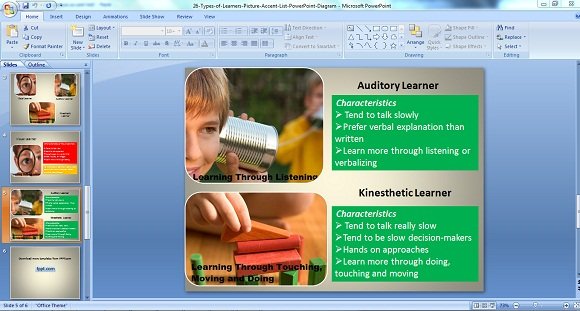Picture Accent List For Kinesthetic, Auditory And Visual Learners
Fact is, there are three different types of learners but fortunately, you can use different types of SmartArt graphics in PowerPoint to cater to their needs. For the Visual Learners, there are SmartArt graphics that weigh heavily on the graphics or images like the Continuous Picture List SmartArt, Horizontal Picture List, Picture Accent List and Picture Caption List.
Apart from this, there are other SmartArt wherein you can add images or pictures to aid your presentation better. Needless to say, it will make your presentation more aesthetically appealing and attractive especially to visual learners.
Understanding Different Types Of Learners Using Picture Accent List
In this article, the graphics used to discuss the different types of learners is the Picture Accent List, and if you are a Visual Learner, it will be easier for you to understand.

As shown in the graphics above, the types of learners are as follows:
- Visual Learner – learning through seeing
- Auditory Learner – learning through listening
- Kinesthetic or Tactile Learner – learning through moving, touching or doing
The main importance why managers and business owners need to understand the different types of learners is for them, including you, to have an idea on how to relate and communicate with your colleagues or employees. It will be helpful for you to communicate with your clients too. Case in point, your employee who is a Kinesthetic Learner is inclined to understand the new business idea if the way on how the message was sent across was made through exercises. Well, not the physical exercise if you know what I mean. But the kind that will make your employees solve problems through moving, working in a group or basically trying their hand on anything so that they could apply the trial and error method, which is the way Kinesthetics are inclined to learn.
However, if your client is an Auditory Learner, it is best if you can prepare a PowerPoint presentation added with a video recording or a video clip to make your point clearer and appealing to this type.
Characteristics Of The Different Types Of Learners

In the graphics as shown above, each type of learner has different characteristics like:
Visual Learners
- Tend to talk fast
- Tend to be impatient
- Use phrases or words that let you visualize or imagine on how it will look like or turn out
- Learning through seeing
This type of learner will learn better if you will start your PowerPoint presentation with, “Imagine this big Pie wherein you will divide it into 8 different parts. One part will be given to Joe (points or approaches Joe) while another part will be given to Jane (points or approaches Jane).” This type of explanation will let Visual Learner see in their mind Joe and Jane sitting and receiving part of the pie as the manager or the baker approaches Joe and Jane. But apart from using words to invoke images, you can also use other visual aids like videos and photos or graphics and it is the reason why Picture Accent List is simply perfect.
Understanding The Characteristics Of Learners For Your Business Advantage

As shown above, the characteristics of Auditory Learners are:
- They tend to talk slowly mainly because they are trying to understand every word that you say
- They prefer verbal explanation that giving them a memo or a note
- They learn more when listening that letting them watch a video clip or show them several PowerPoint slides.
Although watching a video involves listening too, there might be distractions that keep Auditory Learners to comprehend the message that you are trying to send across.
Kinesthetic or Tactile Learners, on the other hand, have the following characteristics.
- They tend to talk slow since the processing of information is done through trial and error wherein they needed to test, touch and move the object around. They rather solve puzzles, draw a maze and place object after the other since this will make them pr0ve that it really works or that it doesn’t.
- They are slow decision-makers too and this is not a bad thing since Tactile Learners tend to balance or weigh things or situations first through hands-on approach.
- They learn more if they can touch it and move it
In a nutshell, whatever type of learner category your colleagues or your clients may belong to, understanding how they process, understand or take in information will be beneficial to you and your business.
